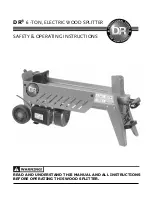
11
WARNING:
When servicing, use only identical Ryobi replacement
parts. Use of any other parts may create a hazard or
cause product damage.
WARNING:
Always wear safety goggles or safety glasses with side
shields during power tool operation or when blowing
dust. If operation is dusty, also wear a dust mask.
GENERAL MAINTENANCE
Avoid using solvents when cleaning plastic parts. Most
plastics are susceptible to damage from various types of
commercial solvents and may be damaged by their use. Use
clean cloths to remove dirt, dust, oil, grease, etc.
WARNING:
Do not at any time let brake fluids, gasoline, petroleum-
based products, penetrating oils, etc., come in contact
with plastic parts. Chemicals can damage, weaken or
destroy plastic which may result in serious personal injury.
LUBRICATION
All of the bearings in this tool are lubricated with a sufficient
amount of high grade lubricant for the life of the unit under
normal operating conditions. Therefore, no further lubrication
is required.
REPLACING HYDRAULIC OIL
(See Fig.11-12)
When new your Ryobi log splitter is supplied with the
correct amount of hydraulic oil. The hydraulic oil in the
log splitter needs to be changed every 150 hours of use.
The recommended grade of hydraulic oil is 22 weight. For
extreme cold environments use 32 weight oil. The unit will
carry approximately 3.5l of oil when fully emptied. (Use the
dipstick for correct fill).
n
Unplug the log splitter.
n
Position the log splitter so that the motor end is slightly
higher than the oil drain plug. (Fig.12)
n
Using an 8 mm hex key, remove the oil drain bolt.
n
Drain the hydraulic oil from the oil tank into a four litre
capacity container.
n
Once the oil has drained from the oil tank, turn the log
splitter on the end with the wheels. (Fig.11)
n
Refill the oil tank with fresh hydraulic oil (3.5L).
n
Place the cleaned dipstick into the oil tank. Remove and
check the oil level.
NOTE:
The oil level should be between the two oil lines
around the bottom of the dipstick as shown in figure 4.
n
Replace oil drain bolt. Tighten securely.
n
Dispose old oil at an oil recycling centre.
SHARPENING THE WEDGE
After using the log splitter for some time, it may be necessary
to sharpen the wedge. Using a fine-toothed file, smooth any
burrs or crushed areas along the cutting edge.
SPLITTING LOGS
(See Fig.7 - 8).
Always place logs lengthwise on the work table and resting
firmly on the side supports. Place logs flat and in the direction
of the grain. Never angle the log to split it or place the log
crosswise on the splitter. Never split more than one log at
a time.
CAUTION:
Never keep pressure on the wood by trying to force the
log splitter for more than five seconds. After five seconds,
the oil will heat and can damage the tool.
n
Place log lengthwise and lying flat on the work table.
NOTE:
If the log is small, place it against the wedge before
starting the splitter.
n
Using the right hand, push down and hold the on/off
switch.
n
Push down and hold the hydraulic control lever with
the left hand. With both the lever and the on/off switch
activated, the ram will push the log into the wedge and
split the wood.
n
Once the log is split, release both controls to return the
ram to the starting position.
FREEING A JAMMED LOG
(See Fig.9 - 10.)
n
Release both controls.
n
After the ram is back at the starting position, insert a
wood wedge under the jammed log.
n
Start the log splitter to push the wood wedge (14)
completely under the jammed log.
n
If the log is still jammed, repeat the above steps as
needed using a thicker angled wood wedge until the log
is completely freed.
NOTE:
Never try to knock the jammed log off the splitter.
Doing so may damage the tool or may cause the log to fly
up and hit someone causing injury.
OPERATION
MAINTENANCE
ENGLISH (Original Instructions)
































